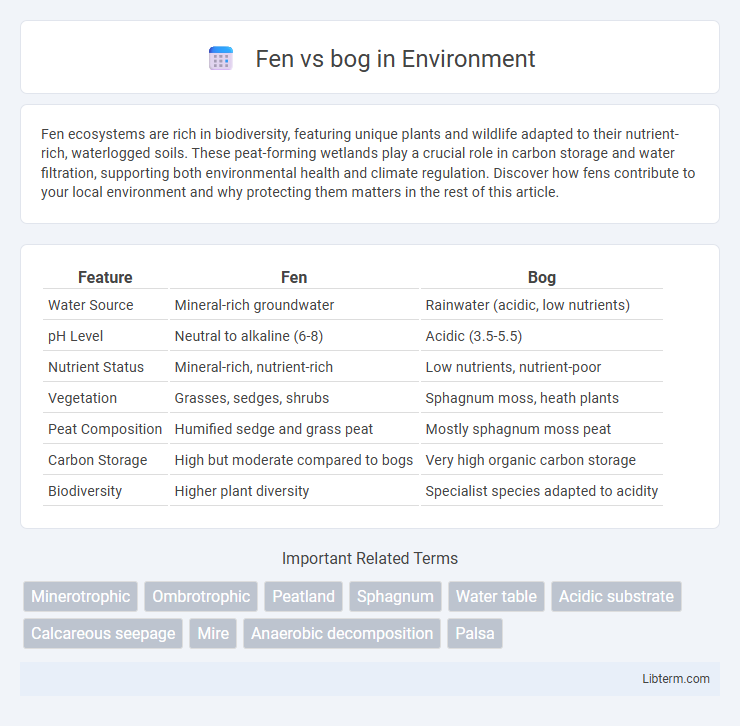Fen ecosystems are rich in biodiversity, featuring unique plants and wildlife adapted to their nutrient-rich, waterlogged soils. These peat-forming wetlands play a crucial role in carbon storage and water filtration, supporting both environmental health and climate regulation. Discover how fens contribute to your local environment and why protecting them matters in the rest of this article.
Table of Comparison
| Feature | Fen | Bog |
|---|---|---|
| Water Source | Mineral-rich groundwater | Rainwater (acidic, low nutrients) |
| pH Level | Neutral to alkaline (6-8) | Acidic (3.5-5.5) |
| Nutrient Status | Mineral-rich, nutrient-rich | Low nutrients, nutrient-poor |
| Vegetation | Grasses, sedges, shrubs | Sphagnum moss, heath plants |
| Peat Composition | Humified sedge and grass peat | Mostly sphagnum moss peat |
| Carbon Storage | High but moderate compared to bogs | Very high organic carbon storage |
| Biodiversity | Higher plant diversity | Specialist species adapted to acidity |
Introduction to Fens and Bogs
Fens and bogs are distinct types of wetlands characterized by their unique hydrology, vegetation, and nutrient availability; fens receive mineral-rich groundwater, supporting diverse plant species, while bogs accumulate acidic peat from sphagnum mosses and rely primarily on precipitation. Fens typically exhibit higher pH and nutrient levels, fostering sedges, grasses, and brown mosses, whereas bogs have low nutrient content and acidic conditions that limit vegetation to sphagnum moss and ericaceous shrubs. Understanding these differences is critical for wetland conservation, ecosystem management, and studying carbon sequestration processes in peatlands.
Defining Wetland Types: What Are Fens and Bogs?
Fens and bogs are two distinct types of wetlands characterized by their water sources, vegetation, and soil properties. Fens are nutrient-rich wetlands fed by mineral-rich groundwater, supporting diverse plant species including sedges and grasses, while bogs are nutrient-poor, acidic wetlands primarily fed by rainfall, dominated by sphagnum moss and ericaceous shrubs. The key difference lies in their hydrology and nutrient availability, which influence their unique ecosystems and carbon storage capabilities.
Key Differences Between Fens and Bogs
Fens are nutrient-rich wetlands with alkaline waters, supporting diverse plant species such as sedges and grasses, while bogs are acidic, nutrient-poor ecosystems dominated by sphagnum moss and ericaceous shrubs. Fens receive water primarily from groundwater and surface runoff, which introduces minerals, whereas bogs depend mainly on precipitation, leading to low mineral content and peat accumulation. The peat in fens is more decomposed and less acidic compared to the highly acidic, spongy peat found in bogs, reflecting fundamental differences in hydrology and biogeochemistry.
Formation and Development Processes
Fens develop in mineral-rich groundwater-fed environments, characterized by slow accumulation of sedge, moss, and herbaceous plants, leading to neutral to alkaline peat formation. Bogs form primarily from rainwater accumulation in poorly drained depressions, resulting in acidic, nutrient-poor conditions dominated by sphagnum moss peat. The hydrological differences influence organic matter decomposition rates and vegetation succession, shaping distinct fen and bog ecosystems.
Hydrology and Water Sources
Fens receive their water primarily from groundwater rich in minerals, resulting in neutral to alkaline conditions, whereas bogs are rainwater-dependent, creating acidic, nutrient-poor environments. Hydrologically, fens maintain a constant water supply through subsurface flow, supporting diverse plant species adapted to stable moisture levels. Bogs rely on precipitation, causing water tables to fluctuate and supporting sphagnum moss that acidifies the habitat, limiting nutrient availability.
Soil Composition and Peat Accumulation
Fens feature alkaline, nutrient-rich soils with higher mineral content derived from groundwater, supporting a diverse plant community, whereas bogs have acidic, nutrient-poor soils primarily formed from sphagnum moss resulting in slow peat accumulation. Peat in fens accumulates at a slower rate due to better decomposition conditions and mineral input, contrasting with the thicker, more acidic peat layers that build up rapidly in bogs. These soil and peat differences profoundly influence the hydrology and ecology of each wetland type.
Plant Life: Vegetation in Fens vs Bogs
Fens support diverse vegetation with species such as sedges, grasses, reeds, and wildflowers thriving in their alkaline, nutrient-rich waters. Bogs feature a more specialized plant community dominated by sphagnum mosses, ericaceous shrubs, and acid-loving plants adapted to nutrient-poor, acidic conditions. The difference in water chemistry between fens and bogs creates distinctly varied plant ecosystems essential for wetland biodiversity.
Wildlife and Biodiversity
Fens support a rich diversity of plant species including sedges, grasses, and wildflowers, creating habitats for insects, birds, and mammals such as water voles and dragonflies. Bogs, characterized by acidic, nutrient-poor conditions, sustain specialized flora like sphagnum mosses, cranberries, and carnivorous plants, hosting unique wildlife such as peatland birds, including the bog-robin and specialist invertebrates. The biodiversity found in fens is generally more varied due to higher nutrient levels, while bogs provide niche environments critical for rare and endangered species.
Ecological Importance and Climate Impact
Fens and bogs are critical peatland ecosystems that store vast amounts of carbon, playing a vital role in mitigating climate change by sequestering greenhouse gases. Fens, characterized by groundwater influence and higher nutrient levels, support diverse plant species and more productive habitats, enhancing biodiversity. Bogs accumulate acidic, nutrient-poor peat dominated by sphagnum mosses, creating unique carbon-rich environments that slow decomposition and maintain long-term carbon storage critical to global carbon cycles.
Conservation and Threats to Fens and Bogs
Fens and bogs are critical wetland ecosystems supporting unique biodiversity and providing essential ecosystem services such as water filtration and carbon storage. Fens, characterized by alkaline, nutrient-rich waters, face threats from peat extraction, drainage, and agricultural runoff, which alter hydrology and nutrient balance, leading to habitat degradation. Bogs, acidic and nutrient-poor, are vulnerable to peat mining, climate change, and afforestation, which disrupt carbon sequestration and endanger specialized plant and animal communities.
Fen Infographic

 libterm.com
libterm.com